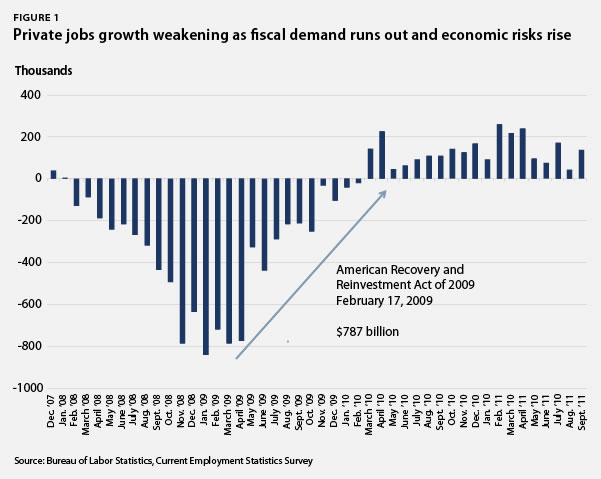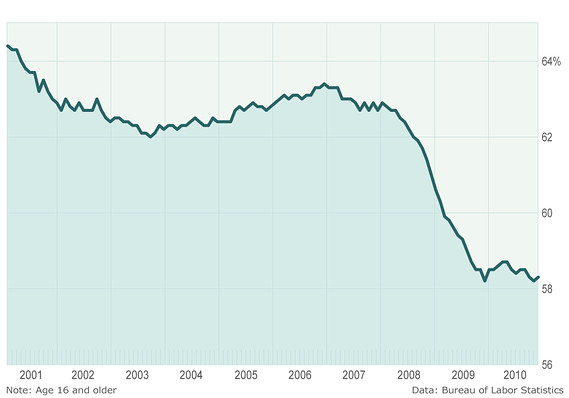|
DECEMBER
2010 UNEMPLOYMENT DATA*
(U.S.
BUREAU OF LABOR STATISTICS)
OFFICIAL UNEMPLOYMENT:
9.4%
A year earlier, the number of unemployed
persons was 15.2
million, and the jobless rate was 9.9 percent. [BLS]
| White |
8.5% |
| African
American |
15.8% |
| Hispanic |
13.0% |
| Asian** |
7.2% |
| Persons with a disability ** |
14.3% |
| Men
20 years and over |
9.4% |
| Women
20 years and over |
8.1% |
| Teens
(16-19 years) |
25.4% |
| Black
teens |
44.2% |
| Officially
unemployed |
14.5
million |
HIDDEN UNEMPLOYMENT
| Working
part-time because can't find a full-time job: |
8.9
million |
| People
who want jobs but are
not looking so are
not counted in official statistics (of which about 2.5 million**
searched for work during the prior 12 months and were available
for work during the reference week.) |
6.5million |
|
Total:
29.9 million (18.7% of the labor force)
|
Source: http://www.bls.gov/news.release/pdf/empsit.pdf
**Not seasonally adjusted.
*See Uncommon Sense #4 for an explanation of the unemployment measures.
In addition, millions
more were working full-time, year-round, yet earned less than
the official poverty level for a family of four. In 2009, the
latest year available, that number was 16.3 million, 16.4 percent
of full-time, full-year workers (estimated from Current
Population Survey, Bur. of the Census, 2010).
In November,
2010, the latest month available, the number of job
openings was 3.2 million, "little changed from 3.3
million in October. Since the most recent series trough in July
2009, the number of job openings has risen by 0.9 million, or 39
percent. This trough immediately followed the end of the recession
in June 2009 (as designated by the National Bureau of Economic Research).
Even with the gains since July 2009, the number of job openings
in November remained 1.1 million below the 4.4 million openings
when the recession began in December 2007." Job
Openings and Labor Turnover Estimates, January 11, 2010.+
Thus there are now more than 9 job-wanters for each available job.[Numbers
are not comparable with earliest data as methods have been revised.]

Source: http://www.americanprogress.org/issues/2011/01/december_jobs.html
Employment-population
ratio 
Mass
layoffs: "Employers
took 1,586 mass layoff actions in November involving 152,816 workers,
seasonally adjusted, as measured by new filings for unemployment
insurance benefits during the month, the U.S. Bureau of Labor
Statistics reported today. Each mass layoff involved at least
50 persons from a single employer. The number of mass layoff events
in November decreased by 65 from the prior month, while the number
of associated initial claims increased by 4,757. In November,
354 mass layoff events were reported in the manufacturing sector,
seasonally adjusted, resulting in 39,465 initial claims. Over
the month, the number of manufacturing events decreased slightly,
while associated initial claims increased by 2,027."
BLS, 12/22/10
....
"REVIEW OF 2009 For all of 2009, on a not
seasonally adjusted basis, the total numbers of mass layoff events,
at 28,030, and initial claims, at 2,796,456, reached their highest
annual levels on record. Among the 19 major industry sectors in
the private economy, manufacturing had the most initial claims
in 2009 (1,137,106), followed by administrative and waste services
(294,709) and construction (205,765). Manufacturing also had the
largest over-the-year increase in total annual initial claims
(+266,796), with retail trade (+57,283) and administrative and
waste services (+48,039) experiencing the next largest increases.
Among the major industry sectors, 12 registered series highs for
both mass layoff events and initial claims in 2009: mining; construction;
wholesale trade; retail trade; transportation and warehousing;
finance and insurance; real estate and rental and leasing; management
of companies and enterprises; administrative and waste services;
health care and social assistance; arts, entertainment, and recreation;
and accommodation and food services.
....
Among the 4 census regions, the Midwest reported the highest number
of mass layoff initial claims filed during 2009 (892,202), followed
by the West and the South. All 4 regions experienced over-the-year
annual increases, with the largest increases taking place in the
Midwest (+215,611). The Midwest, Northeast, and South also reached
program highs for total initial claims in 2009. ...."
(BLS, January 27, 2010)
+
"The number of job openings in November
(not seasonally adjusted) increased from 12 months earlier for
total nonfarm and total private. The level was little changed
over the year for government. Over the year, the job openings
level increased in seven industries and was essentially unchanged
in the remaining industries. The job openings level was up over
the year in all four regions."
|

